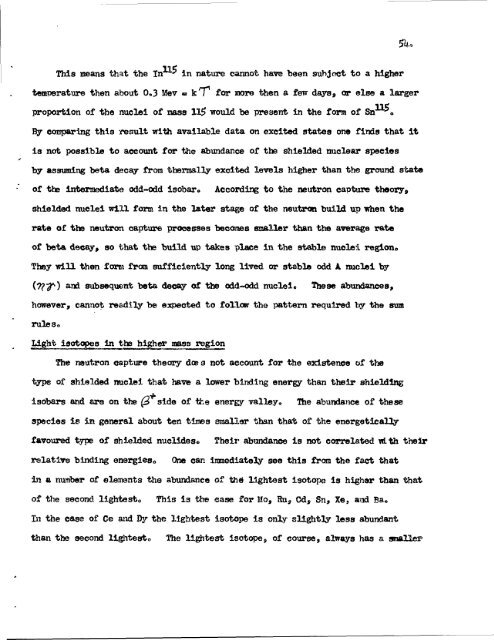View Document - OSTI
View Document - OSTI
View Document - OSTI
Create successful ePaper yourself
Turn your PDF publications into a flip-book with our unique Google optimized e-Paper software.
5u«<br />
This means that the In^^^ in natuire cannot have been subject to a higher<br />
temperature then about 0.3 Mev a k'V<br />
for more then a few days, or else a larger<br />
iwoportion of the nuclei of mass ll5 "would be present in the form of Sn ^o<br />
By comparing this result with available data on excited states one finds that it<br />
is not possible to account for "Wie abundance of the shielded nuclear species<br />
by assuming beta decay from thermally excited levels hi^er than the ground state<br />
of the intermediate odd-odd isobar-<br />
According to the neutron capture theory,<br />
shielded nuclei will f oi*m in the later stage of the neutaran build up when the<br />
rate of the neutron capture processes becc^ies smaller than the average rate<br />
of beta decay, so that the build up takes place in the stable nuclei regiono<br />
They will then form from sufficiently long lived or stable odd A nuclei by<br />
(?p^) and subsequi&nt beta decay of iisB odd-odd nucleic<br />
These abundances,<br />
however, cannot recdily be expected to follow the pattern required hy the sua<br />
rules-<br />
Light isotopes in the higher mass region<br />
The neutron capture theory dcBS not account for the existence of the<br />
t3rpe of shielded nuclei that have a lower binding energy than their shielding<br />
isobars and are on the p side of the energy valley. The abundance of these<br />
species is in general about ten times sraallar than that of the energetically<br />
favoured type of shielded nuclideso<br />
Their abundance is not correlated with their<br />
relative binding enex^ieso<br />
One can inomediately see this from the fact that<br />
in a number of elenents the abundance of th«i lightest isotope is higher than that<br />
of the second lightesto<br />
This is the ease for Mo, Hu, Cd, Sn, Xe, and BEO<br />
In the case of Ce and Ry the lightest isotope is only slightly less abundant<br />
than the second liglitesto<br />
The lightest isotqpe, of course, always has a smaller
















